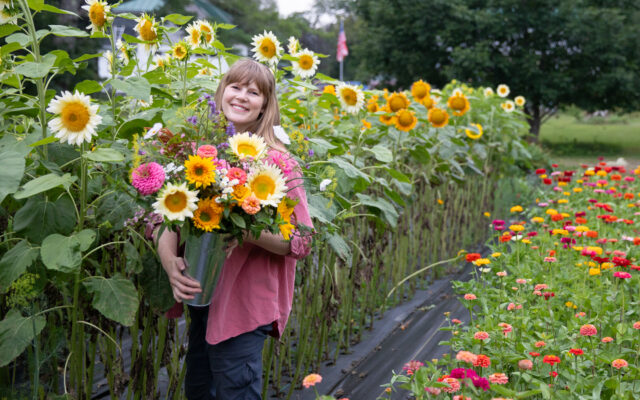
Maine’s cut flower scene is booming. This is how farmers are keeping up.
By Elizabeth Walztoni, Bangor Daily News Staff
Frogmore Flower Farm is one of at least five businesses growing flowers in the Waldo County town of Brooks, population 1,010.
Ashley Petrochenko spent more than a decade planning and watching the market before she opened the U-pick operation, bouquet stand and education site there three years ago. She chose to stand out through agritourism, designing half an acre to resemble a botanical garden that visitors could take home.
She’s not the only Maine grower finding ways to specialize in the state’s cut flower industry, which has boomed over the past decade. As more people join the field, bolstered by the state’s wedding industry and existing farms needing diversified income, some growers are reconsidering their business models and working together where they can.
“It’s crazy now,” said Leslie Leighton, who’s been growing flowers in Greenville for a decade, of the Maine flower farm scene. “It seems as though they’re popping up all over the place.”
The state doesn’t track the number of flower farms in Maine, and national data doesn’t count them either.
Anecdotally, growers agree new farmers are entering the flower market all the time post-pandemic, and customer demand is strong. Mary Lou Hoskins, who grows flowers at Cedar Hill Farm in Exeter, has seen local flower sales grow substantially in the last 10 or 15 years, along with increasing interest in local foods.
It seems like a new flower farm opens in Maine almost every week, she said.
As the board president of the Maine Flower Collective, Hoskins sees the workings of the industry. The cooperative wholesales and distributes local flowers from 41 farmers across the state. It opened in 2023 after several years of work following the 2020 closure of Bennett Wholesale Florist, a Bangor distributor many growers relied on to buy their flowers.
Most collective buyers are designers, according to Hoskins. What they buy is often destined for Maine’s multi-million-dollar wedding industry, plus retail stores, farmers markets and florists.
The state hosted at least 10,000 weddings in 2023, according to industry site The Wedding Report, and the events bring hundreds of millions of dollars into Maine every year.
Dan Nygaard, who has been growing flowers at Dan’s Flower Farm in Sedgwick for more than 20 years, said he’s seen the wedding industry change too. When he moved his farm from Massachusetts decades ago, there was only one other flower grower on the Blue Hill Peninsula. Most people wanted cut blooms to arrange into bouquets themselves for local weddings.
Today, there are more destination weddings, and those families want them “turnkey” without making floral arrangements themselves. The farm also has a seasonal flower subscription, sells at farmers markets, supplies local businesses and does deliveries. Most customers are vacationers, he said.
Juli Perry, his longtime employee and partner who became the business owner this year, said new flower farms open on the peninsula every season. She worries there isn’t enough business to support everyone and is still figuring out how to respond to the increase.
“The growing competition is pushing me out of farmers markets and is forcing me to rethink and refocus on the future of the farm and my livelihood,” she said.
In Greenville, Leighton is doing business as usual, designing wedding florals and selling from a converted Jeep in town under the name Leslie’s Backyard Blooms. The nearest fellow flower farmer is in Sangerville, half an hour away.
“I want to be known as the flower girl up here in Greenville, and I am,” she said.
She considers herself lucky not to have competition in the area. The florist in town is a friend of Leighton’s; they share flowers and equipment when they need to, and she will buy from Leslie’s sometimes instead of a wholesaler.
Roadside stands from hobby growers have been popping up more since the pandemic and sometimes undercut individual flower prices, Leighton said. If she lived in a more populated area, she expects she’d feel the crunch.
A few hours south, collective members don’t feel very competitive because the needs of designers are so varied, Hoskins said. When selling together, farmers can find a niche — for example, she likes to grow “weird things” like pods and sticks.
“Whatever way you grow things, there’s usually some buyer out there, that’s exactly what they want,” she said.
The hundreds of species of cut flowers make it possible to specialize more, especially locally, she said.
About 80 percent of cut flowers sold in the United States in 2019 were imported from Latin American countries, according to research by Washington University. That means they need to hold up in storage for days, ruling out more delicate blooms. They also lose their fragrance over time.
Those flowers are typically grown by low-wage workers on farms using lots of water resources and heavy loads of synthetic fertilizers, pesticides and chemicals. The bouquets are also doused in fungicide when they cross the border, and the carbon impacts of trucking them concerns many growers here too.
Imported flowers will likely always have a role in Maine, Hoskins said. The short growing season means the state couldn’t reasonably supply florals year round, but she hopes people will buy local when they can — and so far, they are.
In Brooks, Petrochenko was preparing for opening day on July 28. She wants the farm to become a community education space and small event center to connect people to each other and to flowers.
Though her town is small and she thinks the market may be too, she said local growers are using their own backgrounds and the things they love to set their farms apart.
“What keeps us going is the positive response from our community and the joy we see in our visitors when they pick flowers,” she said.